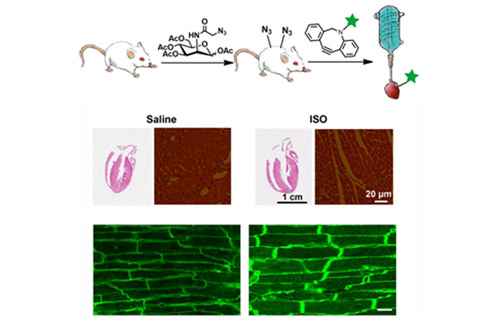Heart failure is the last stage of many cardiovascular diseases, and is one of the leading causes of death in the world. Prolonged cardiac hypertrophy is known to lead to heart failure. How the heart fails as a result of cardiac hypertrophy still remains a question in its research field.
Recently, a research team led by Chen Xing, Professor at Peking University’s College of Chemistry and Molecular Engineering, revealed the dynamic changes of cardiac glycosylation in the cardiac hypertrophy process by using metabolically labeling, glycan imaging and proteomic identification methods. The research was published in the Journal of The American Chemical Society on October 14th, 2014.
The research group pointed out that cardiac glycosylation was dynamically regulated, which remained challenging to monitor in vivo. During the research, a chemical approach was took to analyze the process. They metabolically labeled the cardiac glycan with azidosugars in living rats. Azides, serving as chemical reporters, were chemoselectively conjugated with fluorophores for glycan imaging, thereby allowing enrichment and proteomic identification of glycosylated cardiac proteins.

The research team demonstrated their methodology by visualization of the cardiac sialylated glycans in intact hearts and identification of more than 200 cardiac proteins modified with sialic acids. They further applied this methodology to investigate the sialylation in hypertrophic hearts. They discovered an increase of sialic acid biosynthesis in rats upon the induction of cardiac hypertrophy.Quantitative proteomic analysis revealed that multiple sialylated proteins were upregulated during hypertrophy.
The research team said that the methodology might be further extended to other types of glycosylation. This research focused on the application of metabolic glycan labeling coupled with bioorthogonal chemistry, so it could be useful to research on functions of cardiac glycome during pathophysiological responses. The research team has started work on this area.
This research is sponsored by China’s Ministry of Science and Technology, National Natural Science Foundation, and Peking-Tsinghua Center for Life Sciences.
By Wang Runjian



